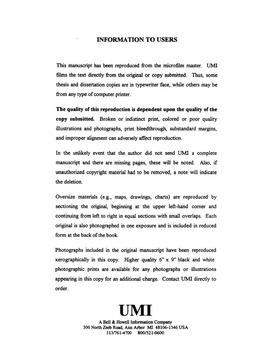| dc.contributor.advisor | Laird, Susan, | en_US |
| dc.contributor.author | Milligan, Jeffrey Ayala. | en_US |
| dc.date.accessioned | 2013-08-16T12:30:05Z | |
| dc.date.available | 2013-08-16T12:30:05Z | |
| dc.date.issued | 1998 | en_US |
| dc.identifier.uri | https://hdl.handle.net/11244/5660 | |
| dc.description.abstract | This inquiry participates in continuing philosophical debates over the appropriate relationship between religion and public education (RRPE) and the conceptual consequences of any such relationship for teachers (Purpel, 1989; Noddings, 1992, 1993; Yob & Laird, 1994, 1995; Gotz, 1997). Identifying problems inherent in RRPE, it proposes criteria for any attempt to renegotiate RRPE and thus reconceptualize teacher: i.e., affirmation of diversity, social authorization, moral-ethical idealism, non-'realist' ontology, love ethic, and meaningfulness. These criteria ground a critique of three paradigmatic conceptions of teacher--as prophet, as technician, as common sense pragmatist--here found inadequate for an historical moment when conflicts over RRPE threaten school's claimed role in democratizing society. This critique concludes, however, that Cornel West's (1989) prophetic pragmatism provides a useful philosophical framework for renegotiating RRPE and reconceptualizing teacher. | en_US |
| dc.description.abstract | Using an embodied literary-philosophical approach to analyze three teacher portraits from Toni Morrison's Beloved (Laird, 1991; Bogdan, 1992; Alston, 1996), this study demonstrates that one portrait--Baby Suggs--represents a teacher whose practice is consistent with prophetic pragmatism and meets the criteria above. Here named the prophetic pragmatic teacher (PPT), the concept derived from that portrait denotes a person who grounds teaching in a sense of the holy as an unschematized response to existential mysteries of human experience (Otto, 1958) and in ongoing creation of democratic community governed by a love ethic. PPT responds to current tensions of RRPE by presenting religious, secular, and scientific narratives on their own terms as contingent, imperfect, but meaningful instances of human desire to explain existence and thereby derive some moral and epistemological structures by which to order human lives. Deploying narrative, art, and poiesis in service of a love ethic, PPT aims to motivate social criticism and inspire ameliorative vision in learners, yet does so from a position of pragmatic intellectual humility. Thus PPT is better able than teachers conceived as prophets, technicians, or common sense pragmatists to negotiate and renegotiate RRPE. For, unlike them, PPT decenters would-be totalizing narratives as necessary but limited attempts to comprehend what we do not know in order to fashion a meaningful present. | en_US |
| dc.format.extent | xi, 339 leaves ; | en_US |
| dc.subject | Literature, Modern. | en_US |
| dc.subject | Literature, American. | en_US |
| dc.subject | Religion in the public schools. | en_US |
| dc.subject | Education, Philosophy of. | en_US |
| dc.subject | Morrison, Toni. Beloved. | en_US |
| dc.subject | Religion, General. | en_US |
| dc.subject | Education, Religious. | en_US |
| dc.title | Negotiating the relationship between religion and public education: Conceptualizing a prophetic pragmatic teacher from Toni Morrison's "Beloved". | en_US |
| dc.type | Thesis | en_US |
| dc.thesis.degree | Ph.D. | en_US |
| dc.thesis.degreeDiscipline | Department of Educational Leadership and Policy Studies | en_US |
| dc.note | Source: Dissertation Abstracts International, Volume: 59-07, Section: A, page: 2415. | en_US |
| dc.note | Adviser: Susan Laird. | en_US |
| ou.identifier | (UMI)AAI9839794 | en_US |
| ou.group | Jeannine Rainbolt College of Education::Department of Educational Leadership and Policy Studies | |
